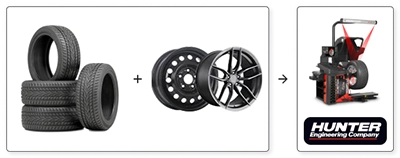Demystifying UTQG: Mastering UTQG to Choose the Right Tire

The Uniform Tire Quality Grading (UTQG) system was introduced by the National Highway Traffic Safety Administration (NHTSA), a division of the U.S. Department of Transportation (DOT), in the late 1970s. Its primary purpose was to provide consumers with standardized information about tire performance characteristics to assist them in making informed purchasing decisions.
Ever since, most tires sold on the market have a stamp on their sidewall indicating what the tire’s UTQG is. In this article, we will develop about what UTQG consists of, clarify/demystify a few popular opinions regarding UTQG and we’ll provide you with the necessary information to assist you in making an informed decision regarding which UTQG rating is most suitable for your vehicle and driving preferences.
What is UTQG and What Does It mean?
The UTQG will always have the following information no matter what tire brand, season or type customers are looking for:
- Treadwear
- Traction
- Temperature
Each of these characteristics will be explained in detail in this article, but in a nutshell, the UTQG is an indicator of how long the tires are expected to last, how well they grip on wet roads and how they will resist heat.
For instance, a tire can have a UTQG rating of 800 B A compared to a UTQG of 100 AA A on another tire. Just by looking at those, we can have a good idea of which tire can be a good fit for different kinds of vehicles and driving habits.
Before diving into the specific details, it is important to know that unlike popular opinions, UTQG ratings cannot be compared between different brands of tires. Therefore, the examples that will follow will only be taking into account the fact that we’re comparing tires within the same tire manufacturer
Treadwear
Data Range
The fist rating we see on a tire sidewall where the UTQG is indicated is a number. The treadwear rating typically ranges from 40 to 800, with higher numbers indicating a longer expected tread life. The expected lifespan of the tire is relative to a base rating of 100. For example, a tire with a treadwear rating of 300 is expected to last three times longer than a tire with a rating of 100 under identical driving conditions (again, only within the same brand). If a X-brand tire has a tread rating of 200 and Y-brand tire has a rating of 400, we cannot say that the Y-brand tires will last twice as long as the X-brand one.
How Is Treadwear Determined?
In order to determine the treadwear number, therefore the expected lifespan of the tire, a specific test course is chosen to simulate real-world driving conditions, including various road surfaces, speeds, and weather conditions. The course typically includes stretches of highway driving, city driving, and abrasive surfaces to represent different types of road wear.
The test tire is mounted onto a test vehicle, which is driven repeatedly over the designated course at a specified speed. The vehicle is equipped with instrumentation to monitor factors such as speed, distance traveled, and tire temperature.
Periodically, the tire's tread depth is measured at multiple points across the tread surface using precision instruments. These measurements are taken before and after each test cycle to track the rate of tread wear over time.
Once the tire reaches the minimum tire remaining tread depth (2/32nd), the treadwear rating is calculated based on the wear rate of the test tire relative to a standardized control tire with a treadwear rating of 100. The higher the treadwear rating assigned to the test tire, the longer its expected tread life compared to the control tire.
To ensure consistency and fairness across different test conditions and manufacturers, adjustments may be made to normalize the results and account for factors such as test variability and environmental influences.Once the testing process is complete, the treadwear rating is validated and certified by regulatory agencies or industry organizations to ensure compliance with established standards and guidelines.
Overall, the treadwear rating provides consumers with valuable information about the expected longevity of a tire's tread under normal driving conditions, allowing them to make informed decisions when selecting tires for their vehicles.
Traction
Data Range
The second information found in the rating of UTQG is the traction of a tire. The rating can be one of the following: AA, A, B or C. Traction tests evaluate a tire's ability to stop on wet surfaces, with AA indicating superior traction performance and C indicating the lowest level of traction.
How Is Traction Determined?
The traction test is typically performed on a specially designed track or surface that can be wetted to simulate rainy or wet road conditions. The track surface may include asphalt or concrete with water spraying systems to maintain consistent wetness.
Standardized test parameters are established, including the speed of the test vehicle, the amount of water on the track surface, and the test duration. These parameters are designed to replicate real-world wet road conditions encountered during driving.
Just as for the treadwear tests, the test tire is mounted onto a test vehicle equipped with instrumentation to measure various performance metrics during the test. This instrumentation includes sensors to monitor tire slip, braking distance, and lateral traction forces.
In order to get the results, the test vehicle is driven over the wet track surface at a specified speed, and various maneuvers are performed to evaluate the tire's traction performance such as, but not limited to, straight-line braking, cornering, acceleration tests, and so on.
During the test runs, data is collected on the tire's performance characteristics, including its ability to grip the road surface, resist hydroplaning, and maintain stability during braking and cornering maneuvers. This data is recorded and analyzed to assess the tire's traction capabilities. Afterwards, based on the test results, the tire's traction performance is evaluated and assigned a traction rating according to the UTQG grading scale. Ratings range from AA (highest) to C (lowest), with AA indicating superior traction performance and C indicating the lowest level of traction.
There is, unfortunately, no numerical difference specified between these grades within the UTQG system. The best clue we can have on the tire’s performance based on the traction rating is that a tire with an AA rating are expected to offer an optimal traction on wet surfaces, the A rating a decent traction, the B an ok traction, no more, and the C rating which would provide the worst results (again, for tires compared within the same manufacturer).

Temperature
Data Range
Finally, the last rating found on the UTQG specification is the temperature. The ratings are the same as for the traction, just without the AA, so A, B or C.
How Is Temperature Determined?
Temperature resistance tests assess a tire's ability to withstand heat buildup during high-speed operation. Here's an overview of the process involved in conducting temperature tests:
Temperature tests are typically conducted on a specially designed test rig or dynamometer capable of simulating high-speed driving conditions. The test rig includes instruments such as rollers or drums to simulate road contact and generate frictional heat.
As for the other UTQG ratings, standardized test parameters are established, including the speed of the test rig, the load applied to the tire, and the duration of the test. These parameters are designed to replicate the heat buildup experienced by tires during prolonged high-speed driving.
The tire to be tested is mounted onto the test rig, ensuring proper inflation pressure and alignment to simulate real-world driving conditions accurately. The test then begins with the tire rotating at a specified speed on the test rig. As the tire rotates, friction between the tire and the test surface generates heat, simulating the conditions encountered during high-speed driving. Sensors are used to monitor the temperature of various points on the tire's tread and sidewall. These sensors measure the temperature rise caused by friction and heat generation.
Data on the tire's temperature distribution and heat buildup are collected continuously throughout the test. This data includes peak temperatures reached at different points on the tire and the rate of temperature increase over time. Once the tests are over, based on the test results, the tire's temperature resistance is evaluated, and it is assigned a temperature rating according to the UTQG grading scale. Ratings range from A (highest) to C (lowest), with A indicating superior temperature resistance and the ability to dissipate heat effectively.
Just like traction, there is no numerical value determining howA rated tires compare to B rated or C rated tires. Generally speaking, it's fair to say that A-rated tires demonstrate the highest level of temperature resistance. These tires are designed to effectively dissipate heat generated during high-speed operation, reducing the risk of tire failure due to overheating. B-rated tires offer moderate temperature resistance which means that they may not dissipate heat as effectively as A-rated tires, but they still provide satisfactory performance under normal driving conditions.
C-rated tires, on the other hand, have the lowest temperature resistance. These tires are less effective at dissipating heat and may be more prone to overheating during prolonged high-speed driving or under heavy loads.

Do All Tires Have UTQG Ratings?
While shopping for a new set of tires, looking at the UTQG is definitely an important factor that can help decide which tire best suits your needs. However, it is possible that you come across some tires that do not have this information at all. No treadwear, no traction or temperature rating, and this can be normal. There are tire categories that do not have the information because manufacturers don’t necessarily see the relevance of undergoing tests for those. Most tires that do not undergo UTQG tests are typically winter tires and all-weather tires, so UTQG ratings are mostly found on all-season and summer tires. To get more information on the differences between those 4 categories of tires, please refer to this article.
The absence of UTQG ratings on certain tires doesn't necessarily indicate lower quality or performance. Instead, it may reflect differences in the intended use or design of the tire. For example, winter tires may prioritize traction on snow and ice rather than treadwear, so they may not undergo UTQG testing.
How to Use UTQG to Select the Best Tire for Your Vehicle
Although this statement isn’t fully backed up by tire manufacturers or doesn’t express the purpose of why/how UTQG ratings were created, our experience allows us to guide you towards the best tire option for your needs if you want to consider UTQG as a deciding factor.
The most important rating to look at, in our opinion, is the treadwear, the first number of the rating, as it gives information about the longevity of a tire, which is the number concern for customers shopping for new tires after security, according to some studies and our own experience with customers.
The rule of thumb says that the higher the number, the longer a tire is expected to last (when compared to other tires from the same brand).
Also, here is a quick tip that can help you determine if a tire is a good fit for your vehicle/driving habits only by looking at the UTQG: Most tire categories will have similar treadwear ratings in the same tire type regardless of the brand you are looking at.
For instance, tires with a treadwear rating between 40 and 200 will most likely be Summer Track tires, tires designed for track use and offer as much traction as possible to save every millisecond possible, hence why they are usually not very durable.
For tires with a treadwear rating between 200 and 400, these are usually categorized as Summer Ultra-High Performance (UHP) tires. These tires, like Track tires, focus on optimized performance and grip, but they have still been conceived for daily driving on regular roads for performance-oriented vehicles.
Then, for tires with a treadwear between 400 and 600, those are usually All-Season Performance tires. These tires are made to offer great balance between road traction and a great grip without sacrificing too much durability. They are usually made to fit luxury sport sedans and SUVs.
Finally, for tires with a treadwear of 600 to 800, those are the most durable tires found on the market, the All-Season Touring tires. Durability, comfort and quietness are expected to be delivered by those tires.

To conclude, Since the NHTSA introduced the UTQG system back in the late 70’s, it has become a crucial tool for navigating the diverse tire market landscape and aims to empower consumers with standardized information to make informed tire purchases.
As we've explored, UTQG ratings provide essential insights into a tire's treadwear, traction, and temperature resistance, serving as key indicators of performance and durability. Understanding these ratings enables consumers to tailor their tire selection to match their specific driving needs and preferences.
While treadwear, traction, and temperature ratings offer valuable guidance, it's important to remember that UTQG ratings should be considered alongside other factors such as brand reputation, driving habits, and environmental conditions. By integrating UTQG ratings into their decision-making process, consumers can make confident choices that prioritize safety, longevity, and performance.
UTQG serves as a valuable ally for consumers embarking on the journey of tire selection, providing clarity and direction in a sea of options. Armed with knowledge and insight, you can confidently navigate the tire market, finding the perfect match for your vehicle and driving lifestyle.
Don’t hesitate to reach out to our team of experts who will be happy to answer any question you might have and find the best tire that suits your needs!
Dominic Vaillancourt
Automotive expert & Spokesperson


